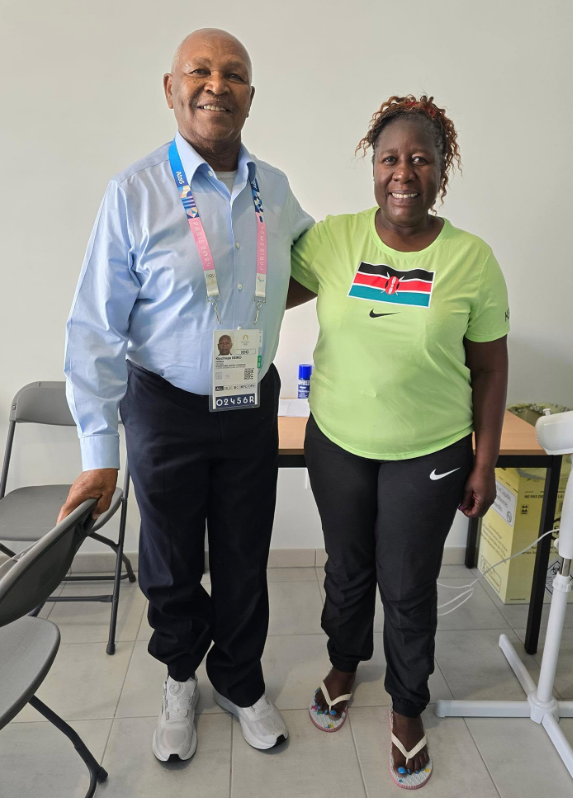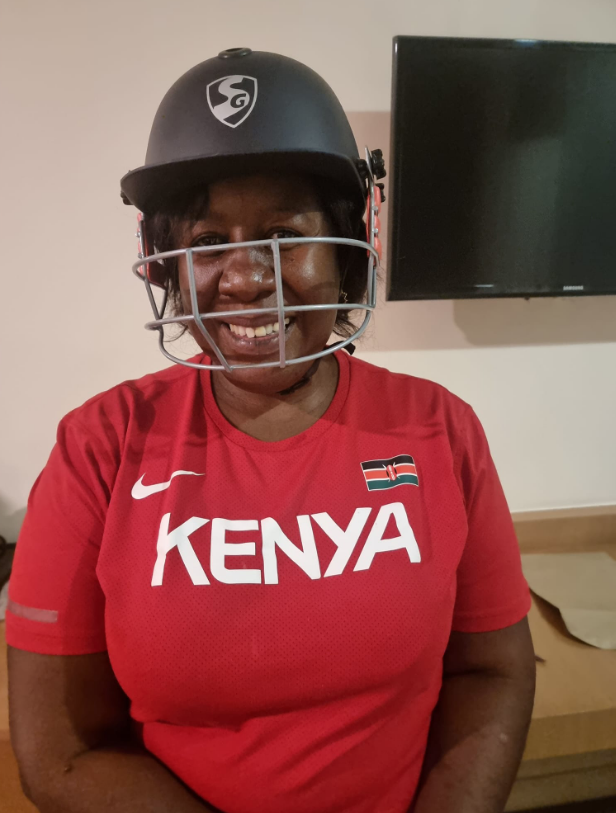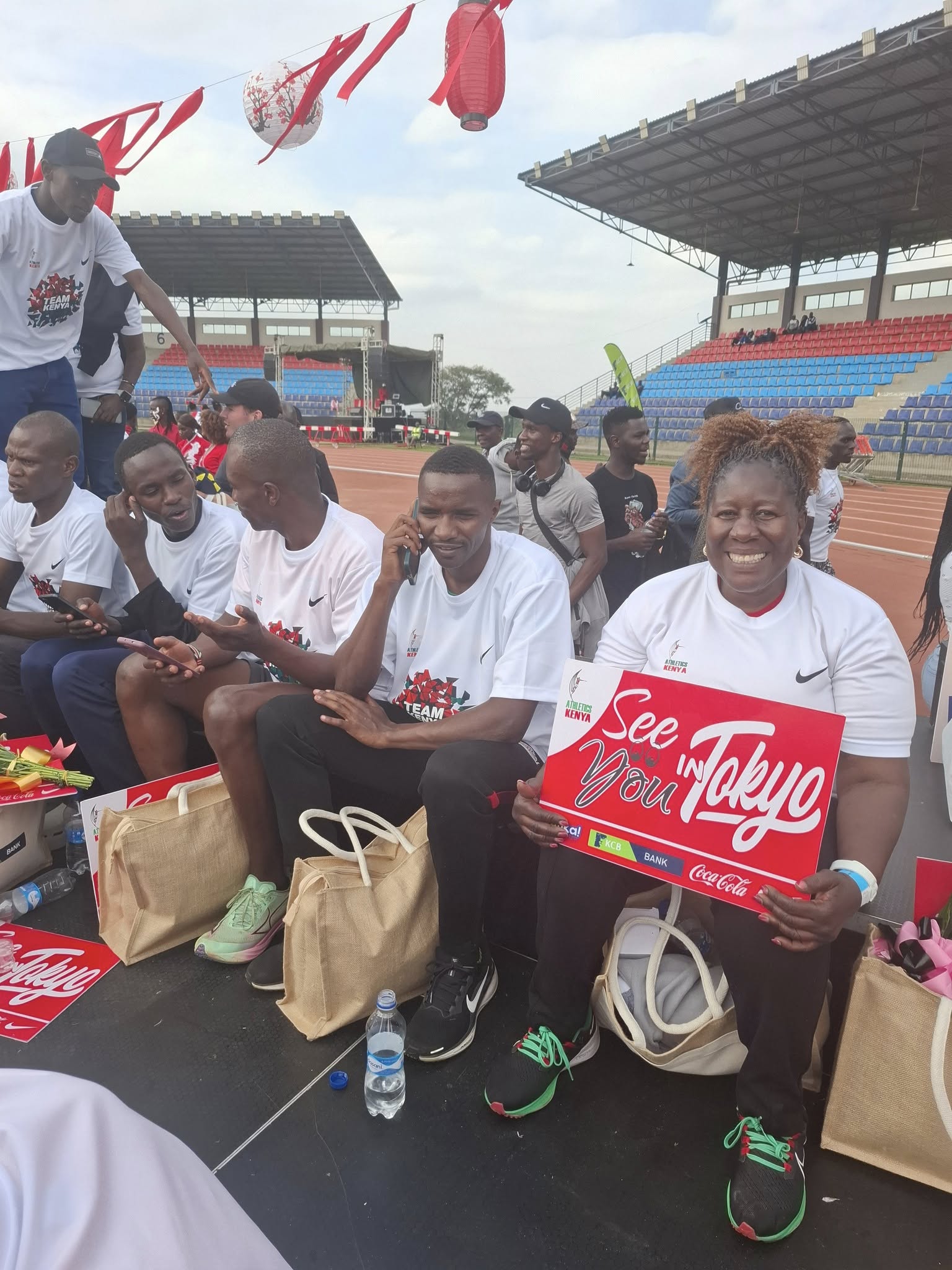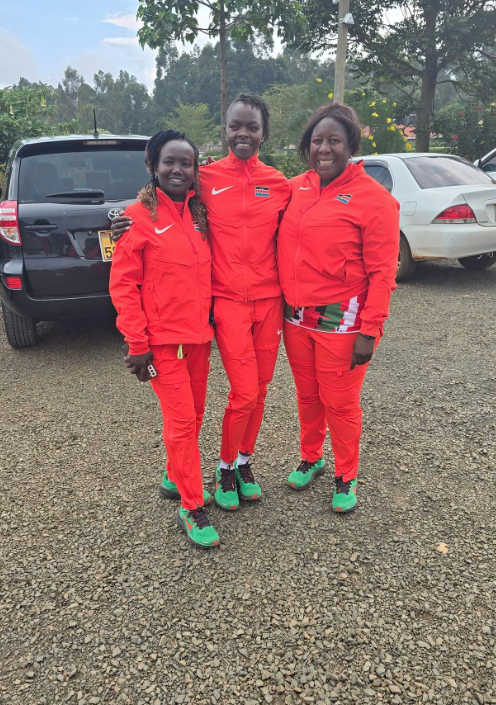
 Jesicca Shiraku with the legendary Kipchoge Keino during the 2024 Paris Olympics /HANDOUT
Jesicca Shiraku with the legendary Kipchoge Keino during the 2024 Paris Olympics /HANDOUT Working tirelessly behind the scenes are the physiotherapists, those trained hands and sharp eyes that mend the broken, rebuild strength and restore hope. They don’t chase medals, but without them, those medals would likely remain out of reach.
Among these unsung heroes is Jessica Shiraku, a name synonymous with medical excellence in Kenyan athletics. For over two decades, Shiraku has stood as the quiet force nursing the country’s top athletes back to glory with nothing but her hands, a sharp mind and unwavering commitment to performance and healing.
A sports physiotherapist, by definition, is a trained expert in the prevention, diagnosis, treatment, and rehabilitation of sport-related injuries. But Shiraku takes it further. She views her craft as a form of art where intuition, experience and science blend seamlessly.
“A physio deals with treatment, diagnosis and management of ailments including pain and also taking care of any musculoskeletal issues,” Shiraku says. The musculoskeletal system encompasses the bones, muscles, joints, and connective tissues (like ligaments and tendons) that enable movement and provide support to the human body.
It's responsible for a wide range of functions, from simple actions like walking to complex movements like playing sports. Disorders of this system can result in pain, limited mobility and reduced overall function. Her tools are as simple as they are effective; her hands and also rely on machines.
“Most of the
time, the physiotherapists use physical agents rather than the way doctors prescribe
medication. I use my hands to relieve pain. I may also use some machines like
electrotherapy, which is an ultrasound or Transcutaneous Electrical Nerve Stimulation (TENS) machine to help in relieving
pain.”
She added: “I may also do
the normal joint range of motion to increase range and relieve pain.”
A TENS machine is a device used by
physiotherapists to help manage pain by delivering electrical impulses
through the skin to stimulate nerves.
 Jessica Shiraku/HANDOUT
Jessica Shiraku/HANDOUTIt's a non-invasive method that can be used to alleviate pain associated with various conditions, including muscle pain, joint pain and postoperative pain. Shiraku’s journey into physiotherapy began not in a clinic, but on the field as an athlete herself, playing hockey and netball and competing in cross-country.
“In my younger
days, I was athletic. I used to play hockey and netball for my
school and also cross country. During our days, it was a must to run cross
country.”
She recalls that
a shin injury would be the catalyst that sparked her intrigue into the human
body and hence she set herself on a journey to help sportsmen and women in the
country.
“I played hockey
up to the national level. The hockey balls are so hard and it happened to hit my
shin bone and that pain lasted forever, almost six months. Then we did not know
what to do.”
“When I grew up, I wanted to get into sports to start helping people. Initially, I just
wanted to be a nurse or a doctor, but then my sister, who was a nurse at the time, told me being a physio is the best and I have never doubted it since I got into
it,” she says.
She studied physiotherapy at Kenya Medical Training College (KMTC), then advanced to Kenyatta University for a Master’s in Health Management. Further training in Europe and Asia cemented her status as a global expert.
Today, she heads the Physical Medical Centre at Nairobi
Hospital, leading a team of physiotherapists, occupational therapists and
orthopaedic specialists.
She also recently founded an orthopaedic and Sports Clinic at the Nairobi Hospital, which, although not yet fully established, has been a haven for rugby, volleyball and track athletes. Shiraku says that she first took charge of Kenya’s junior squads in 2004, gradually transitioning to being a physio of the country’s top talents.
“I have been a
physio in Team Kenya since 2004, which is a very long time. I was very young
then. In my early days, I used to work with junior athletes when they were
travelling and also in camps, I would be with them,” she says.
She has taken
care of some of the country’s biggest stars, including world 800m record holder
David Rudisha, triple Olympic 1,500m champion Faith Kipyegon, four-time world
champion Vivian Cheruiyot, Milcah Chemos, 2012 Olympic steeplechase bronze
medallist, two-time Olympic steeplechase champion Ezekiel Kemboi and Olympic
800m champion Emmanuel Wanyonyi, among others.
“I worked with
Rudisha and Kipyegon when they were coming out of their junior ranks and I have
continued taking care of them even in their senior career.”
With years of experience treating sportsmen and women, Shiraku explains the different kinds of injuries they experience in the field. “The injuries cut through all athletes and not just those who run track and field. We have the lower limb injuries and the upper limb injuries.”
“The most common injuries we get are sprains, and this could be the most common ankle sprains. Ankle sprains mean the athlete has torn their ligaments or the Achilles tendon has torn,” she said. Sprains are injuries to the ligaments, which are the strong, elastic tissues that connect bones at a joint.
They occur when a joint is forced into an unnatural position, stretching or tearing the ligaments. This can happen during activities that involve twisting, turning, or landing awkwardly, leading to pain, swelling, and difficulty moving the affected joint.
 Jessica Shiraku (R) after the selection of the Team Kenya for next month's World Athletics Championships in Tokyo/HANDOUT
Jessica Shiraku (R) after the selection of the Team Kenya for next month's World Athletics Championships in Tokyo/HANDOUT“Another common
injury, mostly in young athletes, is the shin sprain. The athlete gets a green
stick fracture and it is common in younger athletes.”
A green stick fracture occurs when the bone bends and
cracks on one side, but doesn't break all the way through, similar to how a
young, green tree branch might break. This happens because younger athletes’
bones are more flexible than adults.
Some of the
other common injuries include groin injuries, with Shiraku highlighting it as a
common injury for athletes and those who play polo.
“The upper limb
injuries include shoulder injuries common in volleyball and rugby, which are contact sports. We also have the rotator cuff tear for baseball players, as well as
tennis elbow and golfer's elbow. This is a pain in the elbow joint because of
repetition. There are also back pains because of the impact.”
“The worst one
and the one which can lead to death is the concussion injury, where an athlete has been hit so hard on the
head that they may pass out. This is mostly common for boxers and contact games.”
Shiraku noted that even the slightest of injuries can turn fatal if not managed well. “The injuries depend on how they have been handled. Whatever injury, even if small, if not well managed, becomes a nightmare. An injury is an injury, whether a broken finger or leg, it needs to be taken good care of.”
Rehabilitation is a science of patience. Each injury
requires a tailored progressive programme starting from pain relief to
functional testing and eventual return to play.
“We have gradual progressive exercises to get the
athlete back and healthy, which means working on the muscles. After that, we go
to functional testing, where you now put the athlete through what they have been
doing, but that is if the athlete is ready, because we are always watching the
body mechanics
The programme, however, varies for different injuries. For an ACL injury, they work on a six-month to one-year programme before releasing the athlete. She noted that for an ACL injury, they refer the athlete to an orthopaedic doctor for surgery.
Fractures take a long time to heal because of bone formation, but for normal injuries like sprains, it takes five to six days, depending on how severe the injury is. Education is key. Athletes are guided on proper warm-ups, safe training surfaces, and the importance of rest.
“We have talks with athletes and explain to them the
causes of injuries and what they need to do to prevent injuries. For athletics,
track and field, we advise them to do a proper warm-up before going into training.
We also advise athletes not to train on hard ground.”
However, some challenges come during rehabilitation. “The biggest challenge during rehabilitation is failure to follow the programme and athletes hiding their injuries so that they cannot be omitted from a team. Another challenge is finances. Some of the athletes can't afford rehabilitation because it’s not cheap.”
With the World
Championships coming in September, Shiraku, who is part of the Team Kenya contingent, noted that there is much work that goes into preparing a team for a major
competition.
Shiraku noted
that there is a whole team of medical personnel that are involved in preparing
the team, including: orthopaedic doctors, physicians,
nutritionists, strength and conditioning coaches, physiotherapists and psychologists.
“We always know
in advance that you are going to be part of the team, so as athletes go into
camp, we are already there. You watch every move they make.”
With sports medicine evolving rapidly, Shiraku never stops learning. “Medicine changes daily, so you can't hang onto what you did before. You need to know what is happening, what the current trend is and how athletes are being managed.”
“We try as much
as possible to keep pace with what is happening by enrolling on courses outside. I was in Tokyo in May for a sports injury management
course, while last year I was in Monaco.”
Medics need to
know the prohibited drugs by the World Anti-Doping Agency (WADA) when treating
athletes.
“You must also
have the necessary medication with you. For a medic taking care of a team, you need
to understand the drugs athletes are not supposed to take. You can't just pick
any doctor or physio. They ought to have undergone anti-doping training.”
Shiraku noted that technological advancements have made treating patients much easier. “I have seen a lot of advancements in medicine. In 2004, the use of Magnetic Resonance Imaging (MRI) was not even in force. Now you can identify the muscles and muscle fibres you need to work on.”
 Jessica Shiraku (R) with world 800m champion Mary Moraa and former world marathon record holder Mary Keitany (L) /HANDOUT
Jessica Shiraku (R) with world 800m champion Mary Moraa and former world marathon record holder Mary Keitany (L) /HANDOUTThese devices deliver acoustic energy waves to injured areas, stimulating the body's natural healing process and potentially improving athletic performance. The advancement of the ice bath has further helped in muscle relaxation.
“After an
athlete has done some running, body temperature is high and the muscles are
also fatigued. Ice helps cool the body and muscles. Before, we
used to just have ice cubes and rub at certain areas but now they have formed immersions
which work on the body as a whole.”
Some of the highlights of her career include the
2015 Beijing World Championships, where she witnessed team Kenya top the world
with 16 medals (seven gold, six silver and three bronze).
“The
highlight for me is when you accompany a team and you come back on top of the world, like in China 2015 at the World Championships.”
“I feel very nice seeing the athletes that have come
under my care go on to perform exceedingly well on the global stage or even
when they reach a final, that is very motivational.”
The journey has, however, not been without its
challenges.
“The journey also has its rough
moments, especially when you have some injuries at the camp and you need
to ensure the athlete goes to play. It puts them down and that gets a bit bumpy
and depressing because you can see the athlete is the best at what he or she does
and something happens and maybe we have not been able to resolve that issue
that can put a physio down.”
“We want every athlete to be at their best and firing on all cylinders. As a physio, I am more concerned with the movements; muscles must be in good movement. While injuries are a big blow, Shiraku noted that an athlete getting banned for doping is the biggest low moment.
“Injuries can be
low moments but not as much as when an athlete is suspended for doping, which
puts us down. Our athletes are honestly talented; they can do anything but
somebody somewhere strays them from the path,” she said.












